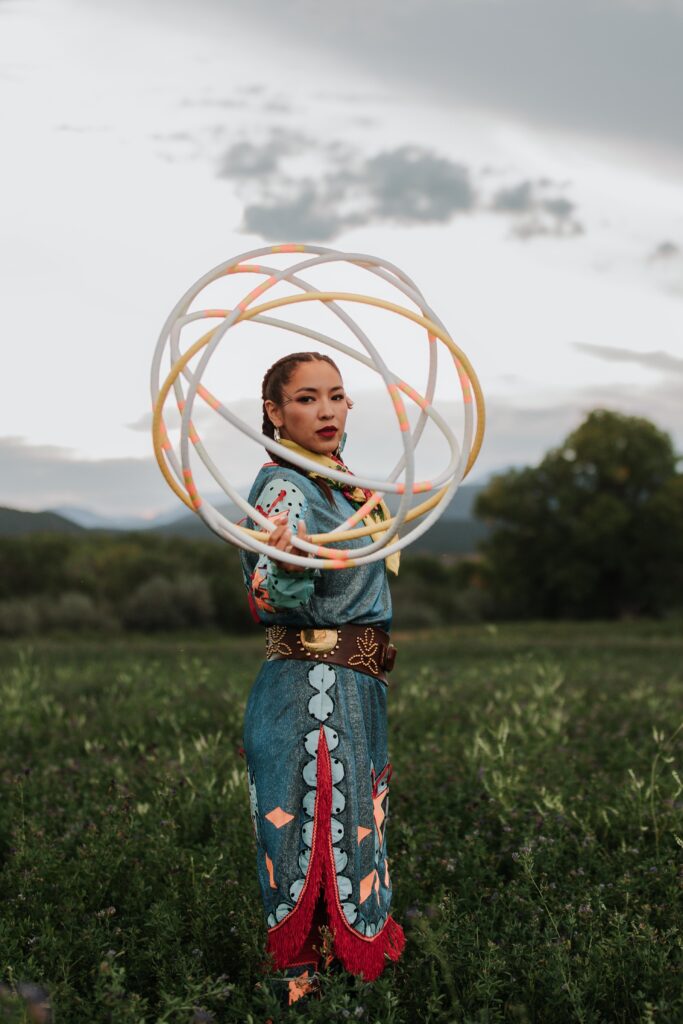At age 8, ShanDien Sonwai LaRance’s father made it a point for her and her two brothers to train together every day at a recreation center in Flagstaff, Arizona. Different-colored hoops sprinkled the floor as the LaRance children prepared for their hour of after-school training in Native American hoop dance. Although she wanted to go downstairs to play with her friends, her dad affectionately said “Practice now, and one day, this dance will open doors for you.”
He was right. Through hoop dance, LaRance has become an advocate for Indigenous communities, sharing her Native American culture with the world. She is affiliated with the Hopi, Tewa, Navajo, and Assiniboine tribes, which has strongly shaped her cultural identity.
At festivals, Indigenous art shows, and powwows, LaRance’s father set up a booth where he sang while LaRance and her two brothers performed hoop dances for tips and donations that served as their monthly allowance. Her older brother, Nakotah, eventually gained widespread fame for his skills, becoming a nine-time world champion in hoop dance. “If you ask any hoop dancer in the world ‘Who is the best Native American hoop dancer?’ they will probably say Nakota LaRance. He left such a strong impact,” she says.
When LaRance turned 19, she followed Nakotah and began touring with the Cirque du Soleil show “TOTEM,” which combined various cultural performances from around the world and emphasized Native American influences throughout. For the next nine years, she traveled internationally, performing in “TOTEM” while simultaneously mastering hoop dance under her brother’s tutelage. When Nakotah left the tour, LaRance stayed. “The show developed me into the young woman I am now,” she says. “From a young age, I’ve always wanted to share my culture, and the show helped me do that and follow my dreams.”
In 2020, when the pandemic struck and “TOTEM” closed, LaRance moved home to her family’s ancestral Tewa lands in New Mexico. That summer, Nakotah tragically passed away in an accident, altering the course of LaRance’s life. Since then, she has dedicated her hoop dancing career to honoring her brother’s legacy and has taken over as the master instructor for his nonprofit organization, the Lightning Boy Foundation.
LaRance’s commitment to uplifting her community and preserving her brother’s memory has made her an inspirational figure. In 2022, she and her father were the featured performers during the inaugural Native American heritage celebration held at the White House. Most recently, LaRance was selected for the New Mexico True Legacy campaign, where she represents the spirit and culture of her home state.
Here, LaRance discusses her biggest inspirations and her future plans.
On Nakotah’s influence:
“After Nakotah came home from tour, he decided he wanted to teach kids how to dance. He liked to say that he had Peter Pan syndrome and he wanted to be a kid his whole life, so he really bonded with children on another level. He actually bonded with everybody on another level because he had a childlike heart. I was still on tour at the time he started and became the master instructor of the Lightning Boy Foundation, with the mission of teaching Indigenous youth how to hoop-dance and keeping them tied to their cultural identities. And after losing my brother, I became the master instructor to keep his legacy and vision alive.”
On the importance of hoop dance to the youth:
“The purpose of teaching is to acknowledge and to physically grasp onto our culture through the hoop dance and share that with the world. Hoop dancing is about the circle of life and respecting everything within that circle. These kids are taught to respect, encourage, and be kind to one another while sharing their stories. They say that as a hoop dancer, we dance for those who cannot, for our elders, for those who have passed, for our ancestors. We dance for our brothers, for our sisters, and we dance for our family. We’re very proud that we can instill that respect and that storytelling aspect into our Indigenous youth and watch them grow up and become confident, healthy young adults.”

On future plans:
“I’ve started working on a new show in Santa Fe at the Mystic. It’s a Native American dinner show, and I’m the creative director. It’s been open for two months now, and we’ve only had two shows, but I’m hoping that it continues on a biweekly basis. We’re really excited because this is one of the first platforms in New Mexico where you can see Indigenous performance consistently without having to be invited to a special event that comes once a year. It’s a really unique experience to see live performances, so I hope to grow the audience and continue sharing hoop dance and my culture with as many people as possible.”


